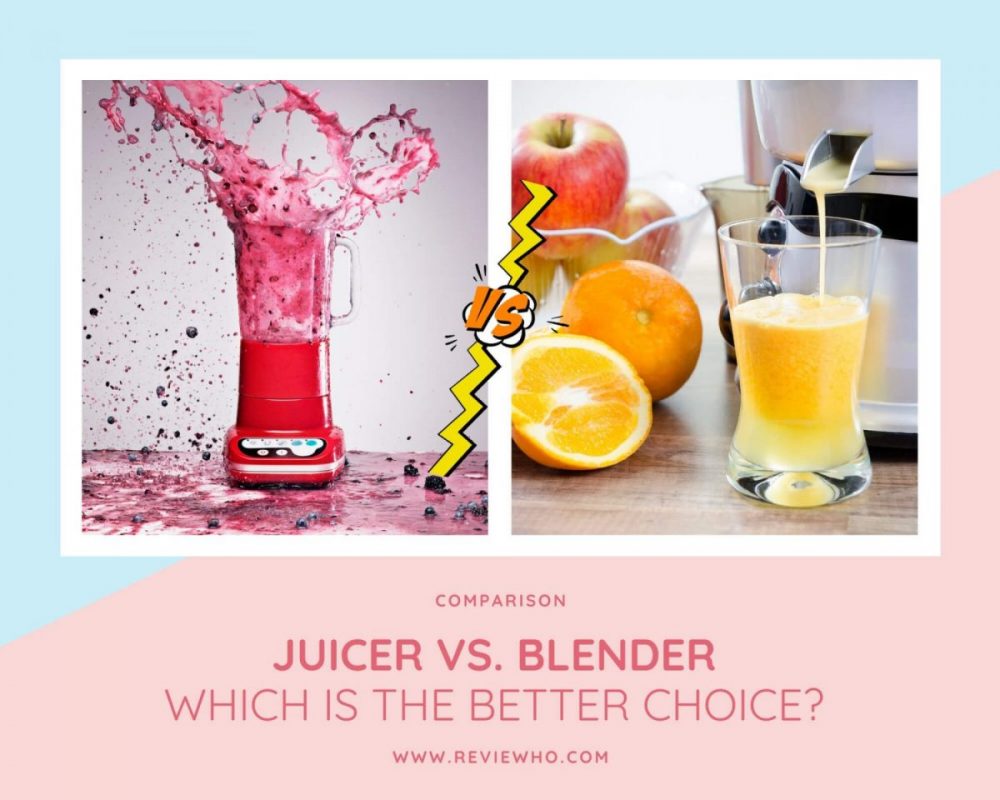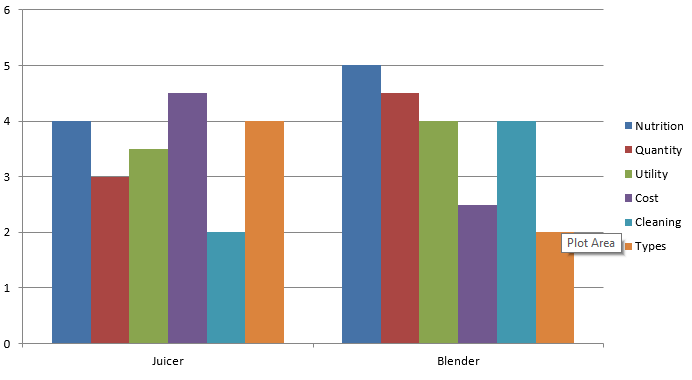In this artificial world of today, the nutrition requirements of the body have changed. In this fast-paced life, we are running perpetually and forgetting about the principal wealth which needs to be preserved. The vitamins present in fruits and vegetables are of the utmost necessity of our body, both for inner and outer beauty.
We tend to skip our breakfast in a hurry but, with portable blenders and juicers, we can create our own nutrition-jammed smoothie in no time.
Before we start evaluating which out of the two, juicer and blender is a better choice and a solid difference between juicer and blender, let us address the common confusion that often circumscribes them. Most people are of the opinion that juicer and blender propose the same purpose, but in reality, their mechanisms are completely distinct.
However, both these objects have their own sets of pros and cons and can make it to your kitchen depending upon your requirements. In the following section, we will be jotting down the specifications accompanying the equipment in concern.
So…let’s take a closer look at those kitchen appliances;
Juicer
The juicer is primarily meant to extract juice from fruits and vegetables by churning and separating its fiber and pulp. Thus, the juice produced from it has a dilute consistency sans the fiber but, contains all the indispensable nutrients that accompany the fruits and vegetables in the first place.
Let us also bring this fact under your notice that because the majority of fruit is made up of its fiber when the fiber is altogether eliminated, the juicer leaves you with a comparatively less amount of liquid and thereby, requires a generous portion of fruits and vegetables to produce glass or two of the juice. Furthermore, the juicers can be categorized under four different kinds and they are,
-
Masticating juicers
Also known by the name of cold press juicers, this apparatus would suit all your needs of producing a glass of fresh and nutritional juice. The masticating juicers usually take longer to produce the juice when compared to its contemporaries and in order to release the liquid, the first press and then crush all the fruit and vegetables thoroughly amalgamate them and make way for the juice.
-
Centrifugal juicers
In centrifugal juicers, the juice is derived from fruits and vegetables by a spinning metal blade that pushes the fiber to the peripheries of the apparatus and presses the ingredients against the strainer only to release them into the container while the pulp is left for elimination. Centrifugal juicers are usually smaller in size and less expensive when placed alongside the masticating juicers.
-
Twin-gear juicers
In this, the ingredients are crushed between two tiny gears that rotate at optimum speeds and hence create a protective shield around the tendency of oxidation in juices.
-
Hand crank juicers
These are the conventional juicers that require manual intervention to secrete the sap out of the fruits and vegetables. They come with a manually-operated tool which when applied with pressure on the ingredients produces the juice.
Blender
The job endowed upon a blender justifies the denomination that it carries; put in your fruits, vegetables, or any other ingredient into the blender and it will seamlessly blend all of them together hence, producing a liquid whose consistency and texture depends upon the amount of water contained in the mixture.
Both the fiber and nutrients are retained in the juice produced by the blender thereby rendering it as wholesome and beneficial to the health.
Blenders are mostly known for the high speed that they implement while obtaining the extract- the standard blenders work at a speed of 20,000 rpm, while the others that come at a higher price, blend with a velocity of 29,000 rpm.
Additionally, as we have already mentioned, the entire fruit or vegetable is capitalized upon while procuring the juice through the blender, thus, a single piece of the ingredient can easily yield an entire glass of the sap. Blenders too are essential of two types,
-
Single serving blenders
The single-serving blenders encumber both the functions of a jug and blender at the same. Once you have mixed all the ingredients and the juice is ready, you can simply remove the detachable blades and the sap is ready to be consumed.
-
Jug blenders
These blenders are the larger version of the preceding variety and can accommodate the content of at least five to six glasses at the same time. So, if you are in the mood to get creative with the ingredients or a large family to serve, the jug blenders are your go-to recourse.
Related:
- Best Immersion Blender reviews and buying guide
- Blendtec TB-621-20 Review
- Best Blenders that Make Soup Reviews
In the section down below, we will be delineating a comparative chart for our readers’ understanding that weighs the characteristics of the juicer and blender and accordingly grants them their individual character.
The pros and cons of a juicer
Pros
- + Efficiency– The efficiency of a juicer wholly depends on its price and the quality of production; if your juicer is acquired from a reputable brand, they will allow you to derive the juice from almost all fruits and vegetables regardless of their hardness. Additionally, the masticators can also effortlessly produce the extract of several types of mushy and juicy fruits and vegetables.
- + Digestion– Because juicers do not include fiber in their final product, they go light on the stomach and are extremely easy to digest. Also, doctors often recommend parents to serve their children the juice derived from juicers as they allow swifter and effective absorption of vitamins and nutrients.
- + Health benefits– As it is known that the process of juicing eradicates a generous portion of the pulp and fiber from the drink, so you can intermix a lot of fruits and vegetables together and then serve it in standard-sized glasses.
Cons
- – They require more effort during the cleaning process and can lead to some wastage.
- – They are usually more expensive than blenders.
- – One cannot add any other solid ingredient to the juicer apart from fibrous fruits and vegetables.
- – They do not contain the pulp of the fruits and vegetables and thereby, are less fulfilling.
The pros and cons of a blender
Pros
- + Efficiency– Almost all kinds of blenders are super affordable and extremely easy to clean. Furthermore, they can be used in the case of all fruits and vegetables and even or the ones that are invariably softer and less pulpy.
- + Digestion– A blender perfectly mixes all the elements of the fruits and vegetables put into it and because the resultant extract is very thick and packed with essential fibers, it accelerates the process of digestion and rids the body of all the harmful toxins and fats. Moreover, the juice obtained from the blender slower down the process of digestion hence, enabling the gradual breakdown of energy and shielding the unstable rise and fall of sugar levels in the bloodstream.
- + Maintenance– The biggest advantage of using a blender is its ease of maintenance; most blenders are accompanied by a removal blade when after procuring the juice and be removed and cleaned. This feature further minimizes the amount of wastage as there remains no chunk of extract stuck at the corners of the blender that cannot be pulled out into the glass.
Cons
- – Blending usually takes longer to intermix all the elements introduced to it when compared with a juicer.
- – The smoothie can contain small charring of the pulp and thus, needs to be churned a few times before pouring it into the glass.
In the following section, we will outline a table that contains the chief differences between a juicer and a blender and their additional pros and cons.
Juicing | Blending |
|---|---|
| Comes with a variety of choices such as centrifugal, twin-gear, masticating and hand-crack. | Comes in two variants and they are jug blenders and single-serving blenders. |
| Clear juices. | Super creamy smoothies. |
| The vitamins, minerals, and phytonutrients are directly injected into the bloodstream. | Clears out the digestive tract by removing toxins and assists regular bowel elimination. |
| The digestive cells are encouraged to focus on cell rest and repair. | Is sumptuous enough and thereby curbs untimely hunger pangs for long. |
Which amongst the two would be preferable?
The question that concerns decoding the answer juicing versus blending will always remain under the light of conjecture and the comparison will stretch till eternity.
All the more, the ground for comparing the juicer vs blender dissolves because the two components serve two completely different purposes. from the looks of it, it can appear that the positive qualities of a blender weigh more than its counterpart, but by judging it from a natural point, it becomes but obvious that they have been designed with sternly different qualities that prosper in their own relevant fields.
According to us, it all depends on personal choice and requirements; if you are someone who has a busy schedule and can hardly scoop u]out enough time for your meal, then the blenders would turn out as your perfect companion; meanwhile, if you prefer lighter portions of fruit and vegetable juice and steer to couple it with your meals, then the juicer is the one.
More Comparison Articles:
- Difference between toaster and toaster oven
- Crock-pot versus Slow Cooker: everything you need to know
- Air Fryer Vs. Convection oven Comparison
- Nakiri Vs Usuba Knife
Feel free to share your observation with me in the comments section!
Also, if you find the information in this post to be useful, be sure to share this post with your friends on Facebook, Twitter, and Pinterest.





